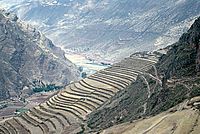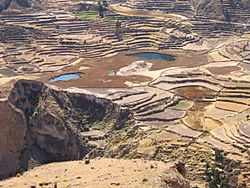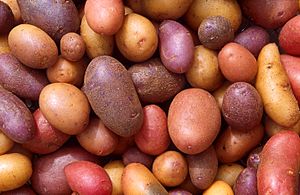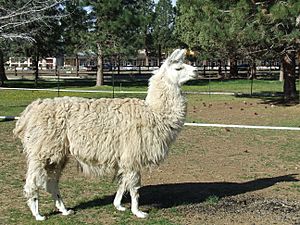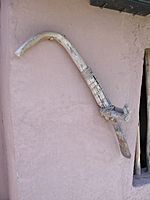Inca agriculture facts for kids
Imagine farming high in the mountains, in dry deserts, and even in steamy rainforests! That's what the Incas did. For thousands of years before the Inca Empire (which lasted from 1438 to 1533 AD), people in the Andes mountains of South America learned how to grow food and raise animals. The Incas became experts at this. They grew all sorts of interesting crops, like potatoes and quinoa, which many other parts of the world didn't even know about back then! They also raised unique animals like llamas, alpacas, and guinea pigs. What's really cool is that the Incas didn't use money like we do, and they had special ways of organizing everyone to get the farming done. Their civilization was one of only a few in the world that developed all on its own, without copying others.
Farming was super important to the Incas. They had to be clever to grow food in the tough Andean mountains where the weather could be tricky. They used smart farming ideas from people who lived before them. This helped them grow lots of different foods in different places – from the dry coast to the cold mountains and the hot jungles. Then, they shared this food with villages that couldn't grow certain things. None of this would have worked without a strong leader, the Sapa Inca, and lots of people to help. They also built amazing roads and big storage buildings called qullqas to keep food safe and move it around their huge empire.
Contents
Farming in Different Lands
The main part of the Inca Empire was high up in the Andes mountains of Peru. This area is mostly above 3,000 metres (9,800 ft) high! Up there, it didn't rain much all year round, it was cold, and the soil wasn't very deep. It could even freeze any month of the year.
To the west of the Andes is the Pacific Ocean. The coast next to it is a desert, often called the driest in the world! The only way to farm there was to bring water from rivers using irrigation.
To the east of the Andes, you'd find bumpy foothills leading down to the Amazon Basin. This area got tons of rain, had lots of plants, and was warm and humid like a rainforest.
How Inca Farming Was Organized
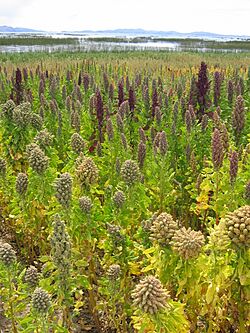
In the Inca Empire, everyone knew their role, especially in farming. The land was split into three main parts: one for the Sapa Inca (the emperor), one for their religion, and one for the farmers themselves. Each family got a piece of land from the leader of their community, called an ayllu. An ayllu was like a big family group. How much land you got depended on your family connections, how important you were, and how many people were in your family.
Farmers grew food for their own families on their land. Instead of paying taxes with money, farmers had to spend some of their time working on the emperor's land and the land for religious activities. When they worked on these special lands, the Incas gave them seeds, fertilizer, and tools. The farmers just needed to do the work! Most communities grew everything they needed, like different crops, animals for wool and meat, and materials for weaving clothes.
Some land was privately owned, especially by the emperors. These were like royal farms, often in the beautiful Sacred Valley near Cuzco, the Inca capital. When an emperor died, his family would inherit his royal estate. The famous Machu Picchu was one of these royal estates! These estates used local workers, but also had special servants called yanakunas. These servants worked directly for Inca nobles. In some places, like the valley of Cochabamba in Bolivia, there were huge state farms just for growing maize (corn). Maize was a very important crop for the Incas, but it couldn't grow in the really high, cold parts of the Andes.
In the desert valleys by the coast, people had more specialized jobs. Some were farmers, and others were fishermen. They would trade with each other. Unlike the mountain people, coastal people sometimes used shells and gold like money. But even there, everyone worked together and shared.
Making Sure Everyone Had Enough Food
Farming in the Andes was tough! It was high and cold, there wasn't much flat land, and the weather could be unpredictable. The Incas were smart and had many ways to make sure they wouldn't run out of food.
Sharing Across Different Heights
One cool idea was called the vertical archipelago. Imagine a staircase of different climate zones going up a mountain. Different crops grow best at different heights. So, the Incas would have farms or friendly communities at various levels – some high up, some lower down. This way, they could get all sorts of foods. For example, potatoes might grow high up, while maize grew a bit lower, and fruit grew even lower. Communities would share these different foods with each other, not by selling, but by trading and helping each other out. Even a single ayllu might have plots of land at different heights to grow a variety of things.
Storing Food for Later
The Incas were big on storing food. They built thousands of special storage buildings called qullqas (or qollqas) in all their major towns and along their famous road system. They often built these qullqas on hillsides where the cool air and wind could keep the food fresh. They even had drainage canals and gravel floors to keep things dry. Food like dried meat (jerky), freeze-dried potatoes (called chuño), maize, and quinoa could be stored for up to two years! This was super important for feeding the Inca army and officials, and also as a backup if the harvests were bad one year. They kept careful track of everything stored using knotted strings called quipu. This was their way of recording information instead of writing.
Smart Farming Tricks
Individual farmers and communities also had tricks to avoid going hungry. Farmers often had many small, scattered plots of land where they grew different kinds of crops. If one crop failed, others might still grow well. In many parts of the Andes, farmers, communities, and even the Inca government built amazing agricultural terraces called Andenes. These were like giant steps built into the mountainside to create more flat land for farming. Andenes also helped protect crops from frost, gave them more sunlight, stopped soil from washing away, and helped water soak in better. Thanks to andenes, the Incas could farm in places that were normally too tricky. In some areas, they also used raised garden beds (Waru Waru) for similar reasons, especially to help drain extra water.
Farming on the Coast and East
On the dry coast, they needed big irrigation systems to water the crops. The people there had more specialized jobs, like farmers or fishermen, and they traded a lot. They even used shells and gold as a kind of money. On the eastern side of the Andes, it rained a lot and was warmer. But the land was steep, making farming hard there too. This region was important for tropical crops, colorful bird feathers, gold, and wood.
Moving Food Around
The Incas used llama caravans to carry food and goods. For example, maize grown on the big state farm of Cochabamba would be carried by llamas to a regional center called Paria. Some was stored there, and some was carried all the way to Cuzco.
What Did the Incas Grow?
- Further information: New World crops
The Incas grew an amazing variety of plants! Here are some of the most important ones:
- Potatoes: These were a super important food, grown at high altitudes, from about 1,000 meters up to 3,900 meters.
- Quinoa: This nutritious grain was grown between 2,300 and 3,900 meters.
- Maize (Corn): This was a very special crop for the Incas. It usually grew up to 3,200 meters, but sometimes even higher (3,500 meters) if the spot was just right.
- Cotton: Grown near the Pacific Ocean and up to about 1,500 meters, cotton was used for making clothes.
- Coca: Grown on the eastern slopes of the Andes (up to 1,500 meters). The leaves were important in Inca culture.
- Cassava: A major crop in the warm Amazon lowlands.
- Other Tubers: They also grew other root vegetables like oca, mashua, and maca.
Besides these main crops, the Incas also grew lots of fruits, vegetables, spices, and medicinal plants. Think about tomatoes, chili peppers, avocadoes, and peanuts! They also had fruit trees like Banana passionfruit (grows from 2,000 to 3,200 meters), mountain papaya (500 to 2,700 meters), naranjilla (or lulo) (500 to 2,300 meters), and Cape gooseberry (500 to 2,800 meters).
Animals on the Inca Farm
Farming for the Incas wasn't just about plants; animals were super important too! They had large herds of animals, sometimes tens of thousands of them. Some of these animals were taken from enemies they conquered.
- Llamas and Alpacas: These were the stars! Their dung (poop) was used as fertilizer for the fields. Llamas and alpacas usually grazed high up in the Andes above where crops could grow, at 4,000 meters (13,000 ft) elevation or even higher. They were incredibly useful, giving the Incas wool for clothes, meat to eat, leather, and a way to carry goods. Llamas were like the Inca's trucks.
- Ducks and Guinea pigs: The Incas also raised ducks and guinea pigs for meat.
Having these animals, especially llamas and alpacas, was a big part of the Inca economy and way of life. They provided wool, meat, leather, were a form of wealth, and helped with transportation.
Cool Tools for Inca Farmers
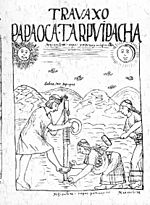
Since the Incas didn't have animals like oxen or horses to help with farm work, they used clever hand tools. These tools were perfect for the steep mountains and the small terrace farms. Here are some of their main tools:
- Chaki taklla: This was a special foot plough powered by people. Imagine a wooden pole with a sharp, curved tip, often made of stone or metal. It had a crossbar where the farmer could put their foot to push the plow into the ground and make a furrow (a long groove for planting seeds). This tool is so good, it's still used in the Andes today for plowing, planting, and building!
- Rawk'ana: This was a type of hoe with a thin wooden blade made from chachakuma wood, not too tall (about 40 cm). Farmers used it to dig up tubers (like potatoes), pull out weeds, and to plant small seeds.
- Waqtana: This Quechua word means a "clod buster." It was used to break up big chunks of soil.
The chaki taklla, rawk'ana, and waqtana had been used by Andean farmers for thousands of years.
They also used other simple but effective tools. They had a mortar and pestle (a bowl and a grinder) to grind grains for cooking. Stone and clay stoves were used to cook foods over fires made with wood or llama dung. Generally made from cobble stones, farming tools like the hoe, clod breaker and foot plough were used to break up the soil and make it easier to get air into it and plant crop seeds.
Farming wasn't just work; it was celebrated with rituals and songs! Teams of seven or eight men, with the same number of women, would work together in lines to prepare fields. The men used foot plows, chaki taklla, to break the soil. The women followed, breaking the clods and planting seeds. This work was done with singing and chanting, striking the earth with their tools all at the same time. One story says that Spanish priests found the songs so pleasant that they were added into church services.
Smart Ways the Incas Used Land
Inca farmers were experts at using land in the best possible way to grow more food.
- Terraces (Andenes): One of their most famous ideas was building stone terraces, like giant steps, on the mountainsides. These terraces stopped the precious Andean soil from eroding (washing away) down the mountain. They also helped keep plant roots warm during cold nights and held in moisture, so plants could grow longer, even at high altitudes. At a place called Tipón, which was an estate for Inca nobles, the terrace walls were very tall, some from 6 to 15 feet high!
- Irrigation: The Incas often watered these terraces using water from melting glaciers nearby. They built canals to carry the water to the crop fields and cisterns (like big tanks) to store the water.
- Draining Wetlands: To get even more farmland, the Incas would sometimes drain wetlands. This let them use the rich, fertile topsoil that was under the shallow water.
- Crop rotation: The Incas also knew that it was good to plant different crops in the same fields each year. This helped keep the soil healthy and produced better harvests.
-
The Inca agricultural terraces at Moray. These circular terraces might have been used for farming experiments.
-
A diagram showing how Inca terrace irrigation worked.
-
In desert areas, puquios (underground and above-ground channels) brought water to crops.
See also
 In Spanish: Agricultura incaica para niños
In Spanish: Agricultura incaica para niños


